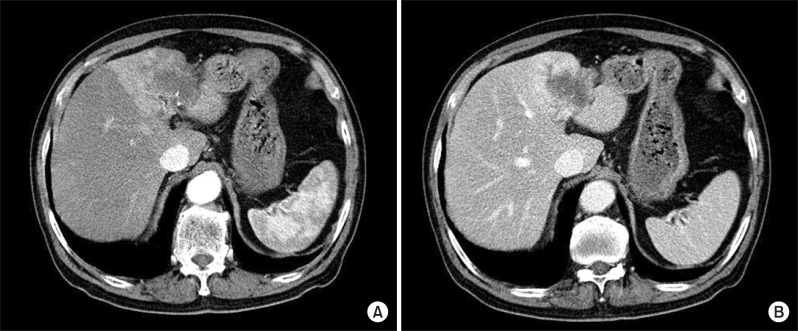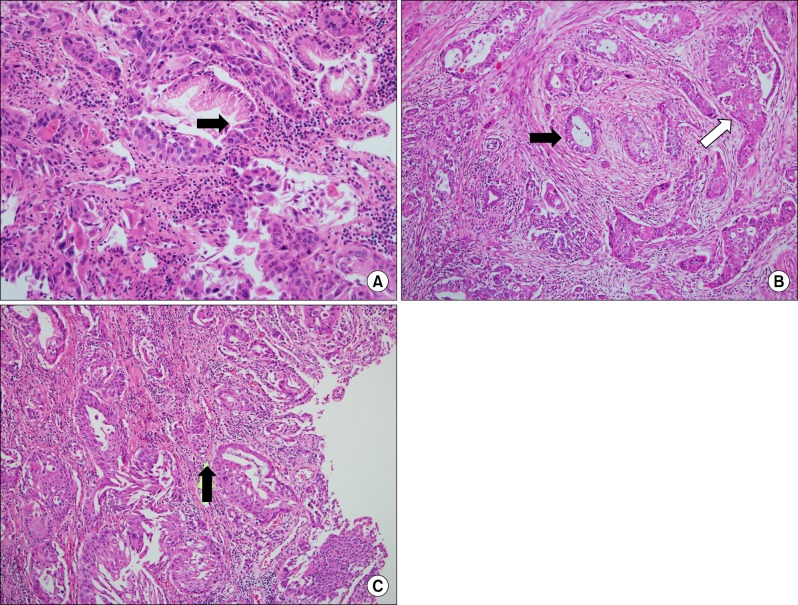Korean J Hepatobiliary Pancreat Surg.
2013 Feb;17(1):38-41. 10.14701/kjhbps.2013.17.1.38.
A case of primary adenosquamous carcinoma of the liver
- Affiliations
-
- 1Department of Internal Medicine, Chungnam National University School of Medicine, Daejeon, Korea. gie001@cnuh.co.kr
- 2Department of Pathology, Chungnam National University School of Medicine, Daejeon, Korea.
- KMID: 2243168
- DOI: http://doi.org/10.14701/kjhbps.2013.17.1.38
Abstract
- Adenosquamous carcinoma (ASC) is a rare tumor of the liver, which carries a poor prognosis. It has been reported mostly in the form of case studies. Recently, we experienced a case of primary ASC of the liver that has been preoperatively considered as cholangiocelluar carcinoma of the liver. Microscopically, the tumor was composed of adenocarcinoma, squamous cell carcinoma, as well as transitional area, including the transformation of adenocarcinoma to squamous cell carcinoma. The patient remained well with no evidence of post-resection complication or recurrence for 15 month.
MeSH Terms
Figure
Reference
-
1. Nakajima T, Kondo Y. A clinicopathologic study of intrahepatic cholangiocarcinoma containing a component of squamous cell carcinoma. Cancer. 1990; 65:1401–1404. PMID: 2155056.
Article2. Yeh CN, Jan YY, Chen MF. Adenosquamous carcinoma of the liver: clinicopathologic features in 12 patients and review of the literature. Int Surg. 2002; 87:125–129. PMID: 12222915.3. Pianzola LE, Drut R. Mucoepidermoid carcinoma of the liver. Am J Clin Pathol. 1971; 56:758–761. PMID: 5126031.
Article4. Kobayashi M, Okabayashi T, Okamoto K, et al. A clinicopathologic study of primary adenosquamous carcinoma of the liver. J Clin Gastroenterol. 2005; 39:544–548. PMID: 15942444.
Article5. Ishak KG, Goodman ZD, Stocker ZD. Tumors of the liver and intrahepatic bile ducts. Atlas of tumor pathology, third series fascicle 31. 2001. Washington, DC: Armed Forced Institute of Pathology;p. 259–263.6. Greenwood N, Orr WM. Primary squamous-cell carcinoma arising in a solitary non-parasitic cyst of the liver. J Pathol. 1972; 107:145–148. PMID: 5074828.
Article7. Gresham GA, Rue LW 3rd. Squamous cell carcinoma of the liver. Hum Pathol. 1985; 16:413–416. PMID: 3980009.
Article8. Arase Y, Endo Y, Hara M, et al. Hepatic squamous cell carcinoma with hypercalcemia in liver cirrhosis. Acta Pathol Jpn. 1988; 38:643–650. PMID: 2463731.
Article9. Moore S, Gold RP, Lebwohl O, et al. Adenosquamous carcinoma of the liver arising in biliary cystadenocarcinoma: clinical, radiologic, and pathologic features with review of the literature. J Clin Gastroenterol. 1984; 6:267–275. PMID: 6725918.
- Full Text Links
- Actions
-
Cited
- CITED
-
- Close
- Share
- Similar articles
-
- Adenosquamous Carcinoma of the Liver: A Case Report
- Adenosquamous Carcinoma of the Ascending Colon: A Case Report and Review of the Literature
- Primary Adenosquamous Carcinoma of the Liver: A Case Report
- A Case of Cutaneous Metastatic Adenosquamous Carcinoma of the Pancreas
- A Case of Primary Adenosquamous Carcinoma of the Liver with Formation of Colonic Fistula



